

A man who saved the life of George Washington. A question:Who is connected with all the following people and things: George Washington, American cavalry, Polish-Soviet war (1919-1921), King Kong, Battle of Britain, Cold War and honorary citizenship of the United States?
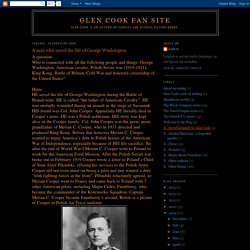
Hints: HE saved the life of George Washington during the Battle of Brandywine. HE is called “the father of American Cavalry”. HE was mortally wounded during an assault in the siege of Savannah. HIS friend was Col. John Cooper. The squadron was named after another double Polish-American hero Tadeusz Kościuszko.
Kazimierz Pułaski. A Polish and American military hero, Kazimierz Pułaski (Casimir Pulaski in English) is almost ubiquitously immortalised on monuments and place names in both countries, but especially in America where some major cities celebrate Casimir Pulaski Day as an official bank holiday.
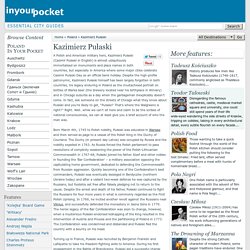
Despite the high-profile patronymic, Kazimierz Pułaski himself has been largely forgotten in both countries, his legacy enduring in Poland as the mustachioed portrait on bottles of Warka beer (the brewery located near his birthplace in Winiary) and in Chicago suburbs as a day when the garbageman inexplicably doesn’t come. In fact, ask someone on the streets of Chicago what they know about Pulaski and you’re likely to get, “Pulaski? That’s where the Walgreens is right?”
Right. Well…while we can’t sit here and claim to be the scribes of national consciousness, we can at least give you a brief account of who the man was. Page 175 - VISITING POLAND. Stanislaw Batowski. Internet Archive Search: Kosciuszko. History Dinner Table. Purpose: Imagine if you could gather a group of people who were instrumental to American history and freedom to dinner.
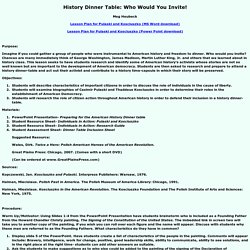
Who would you invite? Chances are many immediately think of George Washington, James Madison, Martin Luther King, Jr. and others that we learned about in history class. This lesson seeks to have students research and identify some of American history’s activists whose stories are not so well known but are important to the development of American democracy. Students are then asked to research and prepare to attend a history dinner-table and act out their activist and contribute to a history time-capsule in which their story will be preserved. Objectives: Materials: PowerPoint Presentation- Preparing for the American History Dinner tableStudent Resource Sheet- Individuals in Action: Pulaski and KosciuszkoStudent Resource Sheet- Individuals in Action: Research GuideStudent Assessment Sheet- Dinner Table Inclusion Sheet Sources: Kopczewski, Jan. Haiman, Miecislaus. Procedure: Committee for National Education - the first polish Ministry of Education - University of Warsaw.
I.
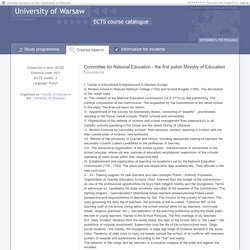
Trends in Educational Enlightenment in Western Europe.II. Modern school in Warsaw Nobilium College (1740) and School Knights (1765). The dissolution of the Jesuit order.III. The creation of the National Education Commission (14.X.1773) by diet partitioning. Theatrical Education definition of Theatrical Education in the Free Online Encyclopedia. Warning!

The following article is from The Great Soviet Encyclopedia (1979). It might be outdated or ideologically biased. History of philosophy in Poland. The history of philosophy in Poland parallels the evolution of philosophy in Europe in general.

Polish philosophy drew upon the broader currents of European philosophy, and in turn contributed to their growth. Among the most momentous Polish contributions were made, in the thirteenth century, by the Scholastic philosopher and scientist Witelo, and, in the sixteenth century, by the Renaissance polymath Nicolaus Copernicus.[1] Subsequently, the Polish-Lithuanian Commonwealth partook in the intellectual ferment of the Enlightenment, which for the multi-ethnic Commonwealth ended not long after the partitions and political annihilation that would last for the next 123 years, until the collapse of the three partitioning empires in World War I. The period of Messianism, between the November 1830 and January 1863 Uprisings, reflected European Romantic and Idealist trends, as well as a Polish yearning for political resurrection. It was a period of maximalist metaphysical systems. Renaissance[edit] Page 175 - VISITING POLAND. Kazimierz Pułaski. Merian-cooper-founder-kosciuszko-squadron-1919.jpg (JPEG Image, 1007 × 1344 pixels) - Scaled (74%)
A man who saved the life of George Washington. Casimir Pulaski 4. March 6, 1745 - October 11, 1779 [[Anthony Waynecommended Pulaski for his heroic actions in New Jersey]] American officers serving under Pulaski had difficulty taking orders from a foreigner who could scarcely speak English and whose ideas of discipline and tactics differed widely from those to which they were accustomed.

This resulted in friction between the Americans and Pulaski and his fellow Polish officers. There was also discontent in the unit over delays in pay, and Pulaski's imperious personality was a regular source of friction with his peers, superiors, and subordinates. Pulaski was also unhappy that his suggestion to create a lancer unit was denied. Despite a commendation from Wayne, these circumstances prompted Pulaski to resign his general command in March 1778, and return to Valley Forge. Pulaski went to Yorktown, where he met with General Horatio Gates and suggested the creation of a new unit. Southern front. General Kazimierz Pulaski: The Deeds of Kazimierz Pulaski. Pulaski was born on March 7, 1745, at a time when the Polish Kingdom was experiencing increasing encroachment on its sovereignty by the surrounding autocratic imperial powers, particularly Russia.

Casimir Pulaski - Polish and American Hero - Polskiinternet.com. 1745 - Born in Poland 1777 - Went to Paris 1777 - Arrived in Philadelphia where he met General Washington 1779 - Died in USA General Casimir Pulaski in a letter to General George Washington: "I came here, where freedom is being defended, to serve it, and to live or die for it...
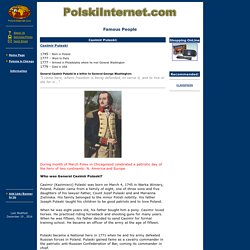
" : N. America and Europe. Casimir Pulaski - Polish and American Hero - Polskiinternet.com. Learn and talk about Targowica Confederation, 1792 establishments, 1792 in Lithuania, Partitions of Poland, Polish confederations. The forces of the Targowica Confederation defeated the forces loyal to the Polish-Lithuanian Commonwealth, the Sejm and King Stanisław August Poniatowski in the Polish–Russian War of 1792.
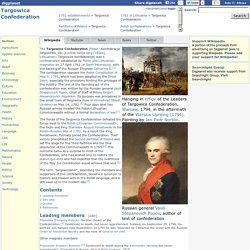
As a result the King, Poniatowski, formally joined the Confederation. Their victory precipitated the Second Partition of Poland and set the stage for the Third Partition and the final dissolution of the Commonwealth in 1795.[2] This outcome came as a surprise to most of the Confederates, who had wished only to restore the status quo ante and had expected that the overthrow of the May 3rd Constitution would achieve that end.[1] The term "targowiczanin", describing the members and supporters of this confederation, became a synonym to traitors and treason acts in the Polish language, and is still used up to the modern day.[3] Leading members[edit] Stanisław Szczęsny Potocki: Marshal (head) of the Confederation.[4] Sentenced to death, but never apprehended.
Other magnate members: See also[edit] Hetman Party.